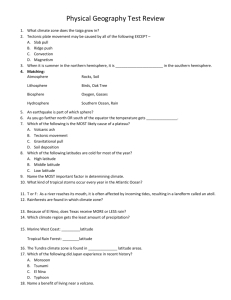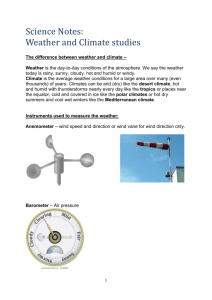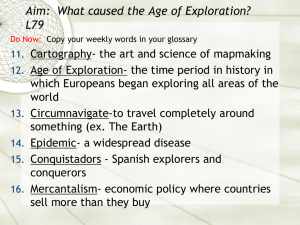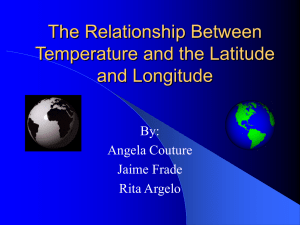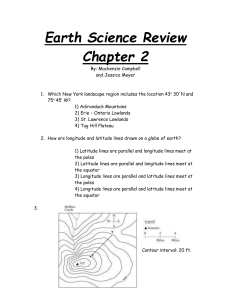Math Journal: Navigating the World
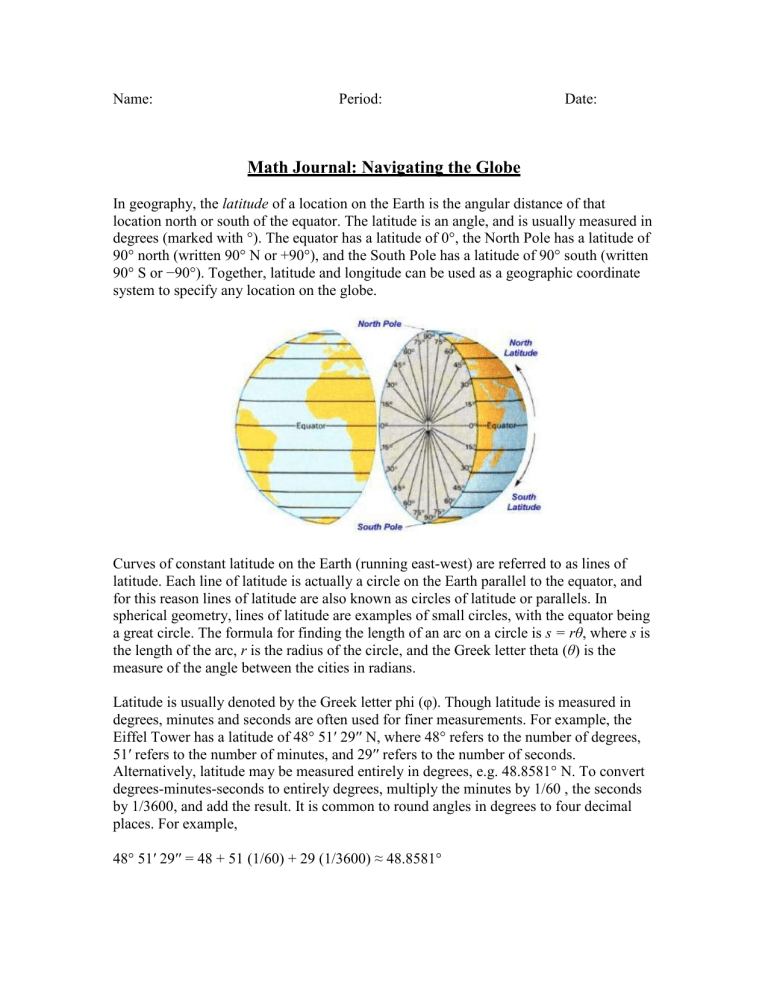
Name: Period: Date:
Math Journal: Navigating the Globe
In geography, the latitude of a location on the Earth is the angular distance of that location north or south of the equator. The latitude is an angle, and is usually measured in degrees (marked with °). The equator has a latitude of 0°, the North Pole has a latitude of
90° north (written 90° N or +90°), and the South Pole has a latitude of 90° south (written
90° S or −90°). Together, latitude and longitude can be used as a geographic coordinate system to specify any location on the globe.
Curves of constant latitude on the Earth (running east-west) are referred to as lines of latitude. Each line of latitude is actually a circle on the Earth parallel to the equator, and for this reason lines of latitude are also known as circles of latitude or parallels. In spherical geometry, lines of latitude are examples of small circles, with the equator being a great circle. The formula for finding the length of an arc on a circle is s = rθ
, where s is the length of the arc, r is the radius of the circle, and the Greek letter theta ( θ ) is the measure of the angle between the cities in radians.
Latitude is usually denoted by the Greek letter phi (φ). Though latitude is measured in degrees, minutes and seconds are often used for finer measurements. For example, the
Eiffel Tower has a latitude of 48° 51′ 29′′ N, where 48° refers to the number of degrees,
51′ refers to the number of minutes, and 29′′ refers to the number of seconds.
Alternatively, latitude may be measured entirely in degrees, e.g. 48.8581° N. To convert degrees-minutes-seconds to entirely degrees, multiply the minutes by 1/60 , the seconds by 1/3600, and add the result. It is common to round angles in degrees to four decimal places. For example,
48° 51′ 29′′ = 48 + 51 (1/60) + 29 (1/3600) ≈ 48.8581°
1. Find the distance between the cities. Assume that the Earth is a sphere of radius 4000 miles and that the cities are on the same longitude (one city is due north of the other.)
Answer: 665.8 miles
City Latitude
Dallas, Texas 32°47’39”
Omaha, Nebraska 41°15’50”
2. Find the distance between the cities. Assume that the Earth is a sphere of radius 4000 miles and that the cities are on the same longitude (one city is due north of the other.)
Answer: 807.3 miles
City Latitude
San Francisco, California 37°47’36”
Seattle, Washington 47°37’18”
3. Assuming that Earth is a sphere of radius 6378 kilometers, what is the difference in the latitudes of Syracuse, New York and Annapolis, Maryland, where Syracuse is about 450 kilometers due north of Anapolis? (Use your graphing calculator to convert the angle in radians to degrees-minutes-seconds.)
Answer: 12.7 degrees
4. Assuming that Earth is a sphere of radius 6378 kilometers, what is the difference in the latitudes of Lynchburg, Virginia and Myrtle Beach, South Carolina, where Lynchburg is about 400 kilometers due north of Myrtle Beach? (Use your graphing calculator to convert the angle in radians to degrees-minutes-seconds.)
Answer: 3.6 degrees
Choice Board
Create a Map
Create a Map that demonstrates what you learned about latitude and distance from the problem you chose. Mapping must show originality, accuracy, and a use of color.
Draw a Picture
Draw a picture that demonstrates what you learned about latitude and distance from the problem you chose. Picture must be detailed and colorful. The picture should be original and accurate.
Write a Short Story
Write a short story using the problem you chose. Story must be at least 5 sentences long. Correct spelling and grammar must be used. Short story should be original and accurate.
Create a Comic
Create a comic strip using the problem you chose. Comic strip should be at least
5 blocks long. Correct spelling and grammar must be used. Pictures should be detailed and colorful. Comic should be original and accurate.
Rubric
CATEGORY
Picture
Mapping
10
The picture is well drawn out and in great detail.
Student shows an understanding of the overall concept.
5
The picture is well draw out and in great detail. Student does not show an understanding of the overall concept.
Short Story Story is at least 5 sentences long.
Correct grammar and spelling is used. Student shows an understanding of the overall concept.
Comic Comic is at least 5 blocks long. Correct grammar and spelling is used.
Pictures are well drawn out. Student shows an understanding of the overall concept.
Story is at least 5 sentences long.
Correct grammar and spelling is used.
Student does not show an understanding of the overall concept.
Comic is at least 5 blocks long. Correct grammar and spelling is used.
Pictures are well drawn out. Student does not show an understanding of the overall concept.
Creativity
Accuracy
Mapping is clear and concise. Color is used throughout the map. Student shows an understanding of the overall concept.
Mapping is clear and concise. Color is used throughout the map. Student does not show an understanding of the overall concept.
Product shows a large amount of original thought.
Ideas are creative and inventive.
Product shows accuracy.
0
The picture is lacking color and clarity.
Student does not show an understanding of the overall concept.
Mapping is neither clear nor concise.
Color is not used throughout the map. Student does not show an understanding of the overall concept.
Story is not at least
5 sentences long.
Correct grammar and spelling are not used. Student does not show an understanding of the overall concept.
Comic is not at least 5 blocks long.
Correct grammar and spelling are not used. Pictures are not well drawn out.
Student does not show an understanding of the overall concept.
Product does not show any amount of original thought.
Product lacks accuracy.



